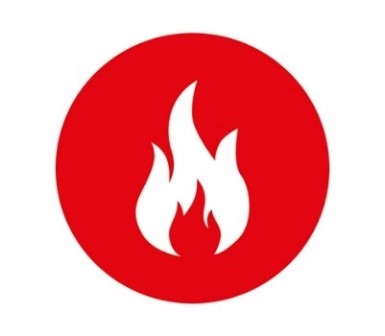Engine room fire – a small rag left after maintenance
 What happened
What happened
There was a small fire in the engine room of a large multi-engined vessel. Work had been carried out the previous night to replace a sheared bolt on a turbocharger on one of the engines. On completion of works and following testing of the turbocharger, this engine was made ready before leaving port. An engineer conducting checks after the works, smelled non-exhaust gas smoke coming from this particular engine.
The Bridge was immediately informed and the engine idled and shut down. The engineer then noticed smoke coming from between the turbo chargers of this engine, followed quickly by a small visible flame. The Hi-fog system was activated above the engine and the fuel QCV (Quick Closing Valve) activated, and a full crew muster took place.
The Hi-fog was stopped having extinguished the fire. A small glow was then noticed and on removal of the exhaust shield the remains of a rag was found and removed. The engine room was then fully checked over and no further issues were found so all fire teams were stood down.

What were the causes/what went wrong?
Initial findings indicated that the incident was caused by the small rag left in an area of high temperature. The rag had been left after some routine corrective maintenance. The following points were noted:
- The area was confined with limited visibility which contributed to the missed removal of all combustibles upon completion of work;
- The fire did not escalate, primarily due to the prompt and professional actions of the crew;
- There were no further combustibles in that area.
Lessons learned
- Engine room housekeeping to be reviewed and monitored to ensure no combustible materials such as rags, gloves, and/or absorbent pads are left lying around;
- An engineer is to be present when starting up any machinery or system post-maintenance, to ensure that the area is safe;
- It was made a requirement to check work areas completely and enforce a rigid sign off procedure, particularly in high risk areas;
- On board Risk Assessments were reviewed and amended to ensure the above are added as part of the control measures.
Members may wish to refer to
- Subcontractor ROV Control Room Damaged By Fire [finding: The layout of equipment and materials within the container, including the presence of oily rags, created a fire risk which was not identified or managed during mobilisation or pre-use inspections. There was no evidence of ROV System audit/pre-mobilisation checklists being completed]
- Fire In Engine Room On Platform Supply Vessel
- Engine Room Fire
Safety Event
Published: 1 June 2020
Download: IMCA SF 17/20
IMCA Safety Flashes
Submit a Report
IMCA Safety Flashes summarise key safety matters and incidents, allowing lessons to be more easily learnt for the benefit of all. The effectiveness of the IMCA Safety Flash system depends on Members sharing information and so avoiding repeat incidents. Please consider adding [email protected] to your internal distribution list for safety alerts or manually submitting information on incidents you consider may be relevant. All information is anonymised or sanitised, as appropriate.
IMCA’s store terms and conditions (https://www.imca-int.com/legal-notices/terms/) apply to all downloads from IMCA’s website, including this document.
IMCA makes every effort to ensure the accuracy and reliability of the data contained in the documents it publishes, but IMCA shall not be liable for any guidance and/or recommendation and/or statement herein contained. The information contained in this document does not fulfil or replace any individual’s or Member's legal, regulatory or other duties or obligations in respect of their operations. Individuals and Members remain solely responsible for the safe, lawful and proper conduct of their operations.
